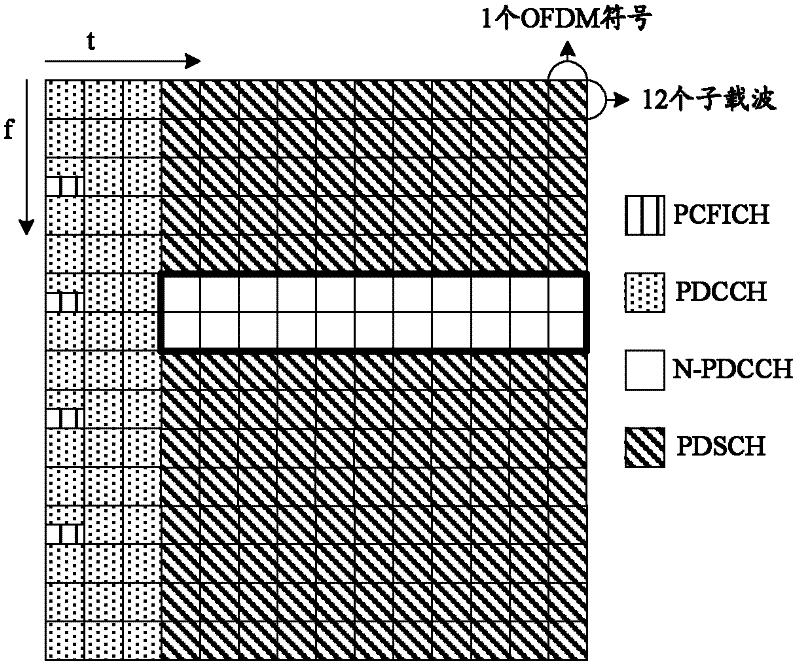Method and system for channel information feedback
A technology of channel information feedback and channel information, which is applied in the direction of using the return channel for error prevention/detection, etc. It can solve the problems of relatively strict control signaling data bit error rate and the accuracy cannot meet PDCCH, etc., to improve feedback accuracy, cost reduction effect
- Summary
- Abstract
- Description
- Claims
- Application Information
AI Technical Summary
Problems solved by technology
Method used
Image
Examples
Embodiment 1
[0059] Step 101:
[0060] The base station configures the available locations of control signaling transmission resources for the UE, such as figure 2 As shown, the physical layer control signaling of user 1 is allocated to some or all of RB(0), RB(5), RB(9), and RB(14). Here, RB(i) means figure 2 For all 14 rectangular positions on the i+1th row from top to bottom, the time-frequency resource positions where these 14 rectangles are located represent 1 RB. Each rectangle represents the length of 1 OFDM symbol in the time domain, and represents the length of 12 subcarriers in the frequency domain. At this time, the base station does not notify the UE of specific location information, but the UE accurately obtains it through blind detection. Therefore, RB(0), RB(5), RB(9), and RB(14) are all possible transmission positions of the physical layer control signaling of UE1.
[0061] Alternatively, the UE obtains possible transmission resources of the physical layer control sig...
Embodiment 2
[0078] In step 102 of Embodiment 1, the value range of RI is {1, 2}.
[0079] Defining the value range of RI as {1, 2} can have the following advantages:
[0080] 1) Low rank can better maintain the robustness of PDCCH transmission;
[0081] 2) It can reduce the probability of misselection of RI and avoid the performance loss caused by the fallback of RI;
[0082] 3) The feedback overhead of the terminal will be reduced to 1 bit.
[0083] For example, if the value range of RI is defined as {1, 2, 3, 4, 5, 6, 7, 8} when there are 8 antennas, at this time, the feedback overhead of each RI needs 3 bits; if the value of RI The range is limited to {1, 2}, and the feedback overhead of each RI only needs 1 bit.
[0084] In addition, if the value range of RI is defined as {1, 2, 3, 4, 5, 6, 7, 8}, according to the existing RI calculation method, it may often occur that RI is greater than 2 in non-correlated channels , such as RI is 3. In this way, after receiving RI=3 recommended...
Embodiment 3
[0087] In step 102 of Embodiment 1, the base station limits the value of RI to 1 or 2 through high-layer signaling. The UE does not need to calculate the RI, but directly calculates the PMI and CQI under the RI sent by the base station.
[0088] In this way, the UE does not need to feed back the RI, and the RI feedback overhead can be reduced to zero.
[0089] If the base station notifies the UE to limit RI=1, the UE sets the searched codebook to be a codebook with rank 1, and sets the number of codeword streams to be 1 at the same time. According to such setting, the UE calculates PMI and CQI according to the downlink channel.
[0090] If the base station notifies the UE to limit RI=2, the UE sets the searched codebook to be a codebook of rank 2, and sets the number of codeword streams to be 2 at the same time. According to such setting, the UE calculates the PMI, the CQI of the first codeword stream, and the CQI of the second codeword stream according to the downlink chann...
PUM
 Login to View More
Login to View More Abstract
Description
Claims
Application Information
 Login to View More
Login to View More - R&D
- Intellectual Property
- Life Sciences
- Materials
- Tech Scout
- Unparalleled Data Quality
- Higher Quality Content
- 60% Fewer Hallucinations
Browse by: Latest US Patents, China's latest patents, Technical Efficacy Thesaurus, Application Domain, Technology Topic, Popular Technical Reports.
© 2025 PatSnap. All rights reserved.Legal|Privacy policy|Modern Slavery Act Transparency Statement|Sitemap|About US| Contact US: help@patsnap.com



